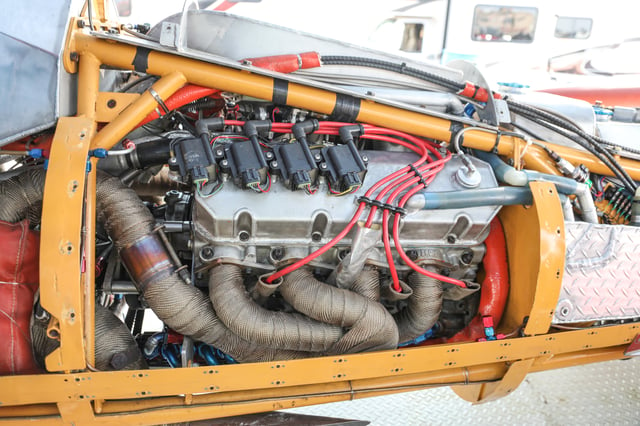The call of the salt is strong, and team Carbinite has heard it for some time now. This year, they brought their innovative streamliner to Bonneville to chase a 400mph record and beat the wind.
Bonneville Speed Week had some of the fastest passes in the event’s 70-year history thanks to four teams that made passes at more than 400mph. Team Vesco’s turbine-powered Turbinator ran in excess of 463mph and took the HOT ROD trophy for fastest pass of the meet, the Speed Demon team ran 452mph with their twin-turbocharged small-block Chevy, Danny Thompson ran a personal best in the Challenger 2 at 450mph, and now Rob Freyvogle has joined the fray with a 413mph pass in his out-of-this-world Carbinite streamliner.
With its space-age styling and beautiful flat metallic copper color, the Carbinite car has become a spectator favorite over the past few years at Bonneville Speed Week and now that the team has worked out the bugs and got a smooth course to run on, the aerodynamics are proving themselves and the class record seems like it could be within their grasp.

Powering the streamliner is a twin-turbocharged, 540-cubic-inch big-block Chevy that uses a Dart Big M block with billet main caps and Diamond pistons topped with Dart Pro 1 heads with 345cc intake runners. Rob ported an Edelbrock intake to match the massaged heads and added a custom manifold top with a paired with a Holley throttle body. Reliability was paramount for the build, so the valvetrain is relatively mild. A Bullet solid roller cam with 267/270 duration, .770-inch lift, and 117-degrees of lobe separation actuates Jesel lifters and Trend pushrods. The big-block is fed up to 33 pounds of boost through a pair of Garrett GT4718 turbochargers that Rob has been using for years. They’ve worked flawlessly, but they’re an old design not optimized for a high-performance gasoline engine and produce more backpressure than a more modern design. Replacing them is a top priority in the off season, as a more efficient design could free up as much as 400 horsepower.

The genesis of the turbo big-block came in 2007, when Rob built a 1963 Pontiac LeMans with remote-mount turbos. He knew the engine and tune were reliable, but he also knew that it would be fruitless to ty to push the LeMans, as compact as it was, to anywhere near 400mph. He needed something far more streamlined.

The design for the streamliner’s body came from an idea hatched by Craig Breedlove back in the 1960s that he used on his rocket-powered Spirit of America dragster. The Carbinite car uses a similar overall design that has been streamlined even further with help from aerodynamicist Eric Ahlstrom. The body uses the vertical surfaces on each rear wheel spat to provide stability while the horizontal surfaces between the wheel spats and the center fuselage are moved during the run to create downforce. The faster the car travels, the less the flaps need to be raised to maintain the same amount of downforce. It’s all handled by the Holley ECU that also provides the speed-based boost control and port fuel injection.

Due in part to the 4,000 pounds of downforce generated by the flaps, there’s no rear suspension whatsoever in the Carbinite streamliner yet it manages to put the power down quite effectively.
Initially, the car ran in the AA Blown Gas Streamliner class but the heat from all of that gasoline-fueled horsepower was hard to attenuate. For 2018 the team made the switch to alcohol, lowering combustion temperatures and increasing power output. Of course, it did move them into the AA Blown Fuel Class and its higher record of 417.020mph set by Tom Burkland in 2004. As with every type of racing, each event provides a learning experience. Initially, Rob was so confident in his engine and aerodynamics that he felt the car would hit 400mph on gasoline, but after the car made a few runs and was sorted out, Rob made the move to alcohol. He told us, ”We wanted the gasoline record first, but we really just wanted to go faster. We sort of gave up on that record for the sake of going as fast as we could possibly go as soon as possible.”

Rob reports that the car is very stable at speed and doesn’t take much steering input to keep going straight as an arrow down the track. Aside from the fact that it’s hitting 420mph through the traps at the end of five miles, Rob reports that, “It’s downright boring.” He also told us that the boost controller from Holley worked well right out of the box and the values are very accurate. That’s important when there’s no place to test and parts have to work on race week. The same can be said for the rest of the engine combo and the Goodyear tires, which have withstood a week’s worth of runs despite putting power down thanks to all that downforce. In fact, the car was able to hit 329mph at the 2 ¼ mile mark, not far off some of the fastest cars on the salt, proving that the traction and acceleration are there, and that more power can help out on the top end.

Speed Week 2018 came with a lot of success and a lot of lessons, but no record just yet. The tremendous speeds managed to take their toll on the quick-change rear end as a failed bearing lead to shredded gears that took the car out of competition. In addition to the turbo upgrade, a modification to the rear axle lubrication is in the works, although space is tight under the streamlined bodywork. After the grueling week, with its triumphs and parts failures, Rob was taxed. It wasn’t too long, though, before the call of the Salt was returned. “I can’t wait to get back.”


